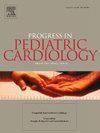Balloon- versus self-expandable stents in the endovascular treatment of adults with aortic coarctation: A systematic review and meta-analysis
IF 0.8
Q4 PEDIATRICS
引用次数: 0
Abstract
Background
Coarctation of the aorta (CoA) is a congenital cardiovascular defect that may persist into adulthood. Endovascular stenting has become the preferred approach, with balloon-expandable stents (BES) and self-expandable stents (SES) being commonly used. However, there is a notable paucity of comparative data evaluating their relative safety and efficacy.
Objectives
We aimed to compare the outcomes of BES and SES in the endovascular management of adults with CoA.
Methods
A systematic review and meta-analysis were performed by searching MEDLINE, Scopus, and the Cochrane Library for studies directly comparing BES and SES in adult CoA patients. Eligible studies included randomized controlled trials and observational studies. Pooled odds ratios (OR) with 95 % confidence intervals (CI) were calculated using a random-effects model.
Results
Three studies (one RCT, two observational), comprising 282 patients, were included, of whom 53.5 % received BES. No significant differences were observed in the cumulative peri-procedural complications [OR 2.5; 95 % CI 0.4 to 18.2; p = 0.07, I2 = 9 %], stent migration [OR 1.1; 95 % CI 0.3 to 4.0; p = 0.94; I2 = 51 %], and persistent hypertension post-intervention [OR 0.8; 95 % CI 0.4 to 1.6; p = 0.60; I2 = 0 %]. Heterogeneity was minimal across most outcomes.
Conclusion
Our analysis suggests that BES and SES offer comparable safety and efficacy in the endovascular treatment of adult CoA. However, the small number of studies and wide confidence intervals warrant cautious interpretation. These findings highlight the need for larger, prospective randomized trials to better guide stent selection in this population.
成人主动脉缩窄的血管内治疗中球囊支架与自膨胀支架的对比:一项系统回顾和荟萃分析
背景:主动脉缩窄(CoA)是一种先天性心血管缺陷,可能持续到成年。血管内支架置入术已成为首选的方法,目前常用的有球囊可扩张支架(BES)和自扩张支架(SES)。然而,评估其相对安全性和有效性的比较数据明显缺乏。目的比较BES和SES在成人CoA患者血管内治疗中的效果。方法通过检索MEDLINE、Scopus和Cochrane图书馆,对成人CoA患者直接比较BES和SES的研究进行系统评价和meta分析。符合条件的研究包括随机对照试验和观察性研究。使用随机效应模型计算95%置信区间(CI)的合并优势比(OR)。结果纳入3项研究(1项RCT, 2项观察性研究),共282例患者,其中53.5%接受了BES。术中并发症的累积无显著差异[OR 2.5;95% CI 0.4 ~ 18.2;p = 0.07, I2 = 9%],支架迁移[OR 1.1;95% CI 0.3 ~ 4.0;p = 0.94;I2 = 51%],干预后持续高血压[OR 0.8;95% CI 0.4 ~ 1.6;p = 0.60;i2 = 0%]。大多数结果的异质性最小。结论BES和SES在血管内治疗成人CoA的安全性和有效性相当。然而,研究数量少,置信区间宽,值得谨慎解释。这些发现强调需要更大规模的前瞻性随机试验来更好地指导这一人群的支架选择。
本文章由计算机程序翻译,如有差异,请以英文原文为准。
求助全文
约1分钟内获得全文
求助全文
来源期刊

PROGRESS IN PEDIATRIC CARDIOLOGY
PEDIATRICS-
CiteScore
0.90
自引率
11.10%
发文量
69
审稿时长
75 days
期刊介绍:
Progress in Pediatric Cardiology is an international journal of review presenting information and experienced opinion of importance in the understanding and management of cardiovascular diseases in children. Each issue is prepared by one or more Guest Editors and reviews a single subject, allowing for comprehensive presentations of complex, multifaceted or rapidly changing topics of clinical and investigative interest.
 求助内容:
求助内容: 应助结果提醒方式:
应助结果提醒方式:


